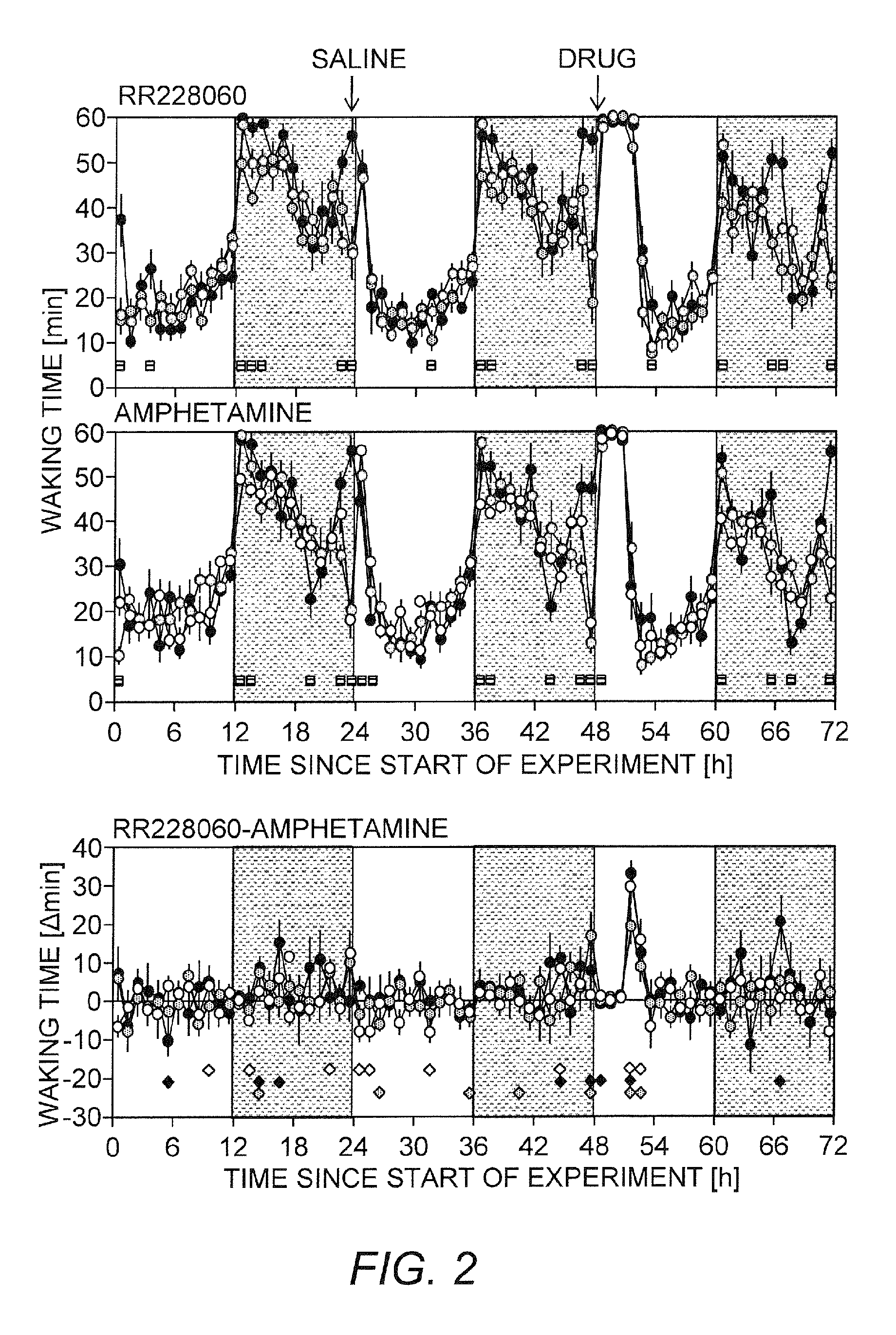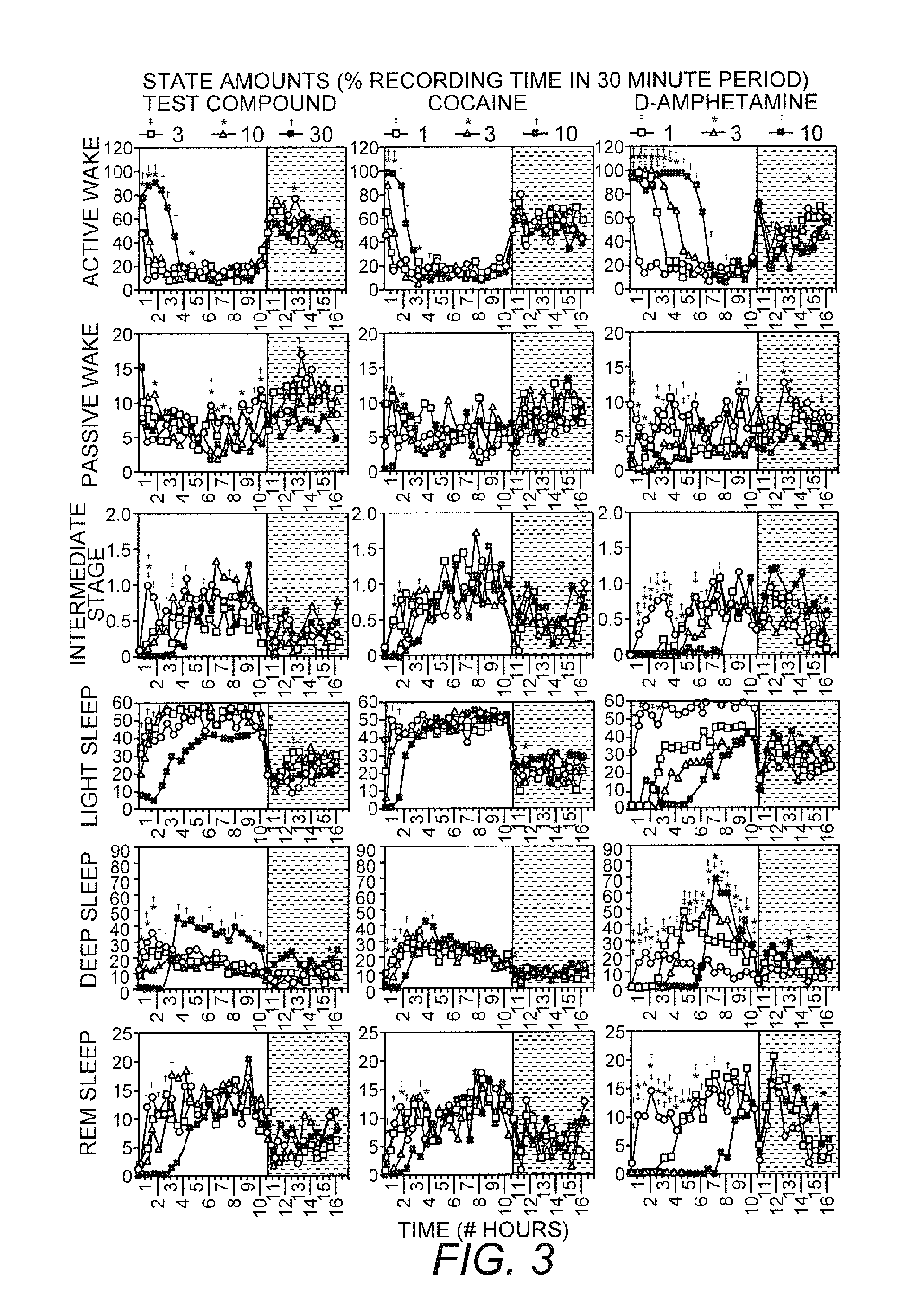Methods for treating or preventing fatigue
a technology for fatigue and treatment, applied in the field of treating or preventing fatigue, can solve the problems of fatigue fatigue, lack of energy, few reports of effective treatment for fatigue,
- Summary
- Abstract
- Description
- Claims
- Application Information
AI Technical Summary
Benefits of technology
Problems solved by technology
Method used
Image
Examples
example 1
[0100]The effects of (R)-(beta-amino-benzenepropyl) carbamate (also known as R228060, hereinafter referred to as test compound) at a dose of 50-150 mg / kg PO on various sleep parameters were evaluated in 8 hypocretin cell ablated narcoleptic mice (prepororexin / ataxin-3 transgenic) and their littermate wild-type mice, and the effects were compared with those of modafinil, a reference wake-promoting compound. The test compound showed significantly increased bouts of wakefulness in both wild-type and narcoleptic mice and was able to normalize sleep patterns of narcoleptic mice.
[0101]Methods
[0102]The polygraph signal (EEG and EMG) was captured with SleepSign (Kissei Comtech), and the sleep stage was visually scored with 10 sec epoch for wakefulness, non-REM sleep and REM sleep. Scoring criteria are: Wakefulness is characterized by desynchronized low-amplitude, mixed frequency (>4 Hz) EEG and high EMG activity. Rhythmic alpha (8-9 Hz) wave (with high EMG activities) may also appear. Non-R...
example 2
[0112]The effects of test compound and d-amphetamine on vigilance states were examined in three mouse strains including C57BL / 6J, AKR / J and DBA / 2J. The test compound showed a genotype-independent increase in wakefulness and longer wakefulness compared to d-amphetamine.
[0113]Methods
[0114]At least 7 adult male mice of inbred strains C57BL / 6J, AKR / J, and DBA / 2J were recorded in 2 sessions of 72 continuous hours. The first 24 h in each session are considered as baseline followed the next day by the saline injection and the next day by 150 mg / kg of the test compound in the first session and 5 mg / kg d-amphetamine in the second session. The two sessions were separated by 7 days (wash-out period) and all injections were intraperitoneal (IP) and performed at light onset (9 am) in a volume of 5 ml / kg.
[0115]Results
[0116]Dose-Response Effects of d-Amphetamine on Sleep Onset:
[0117]C57BL / 6J mice were injected each day with 1, 2, 4, 5, and 8 mg / kg d-amphetamine and the sleep latencies calculated (...
example 3
[0120]The sleep-wake organization in rats after acute administration of the test compound was examined. Treatment with the test compound at 30 mg / kg strongly increased active wakefulness at the expense of time spent in light sleep, deep sleep and REM sleep during the first 3 to 4 hours after the administration. Thus the test compound showed central activity immediately after injection as expressed in changes sleep-wake architecture in rats with a functional peak in effect around 2 hrs after i.p. administration.
[0121]Methods
[0122]The experiments were carried out on male adult Sprague Dawley rats, supplied by Harlan (Borchen, Germany) weighing 240-260 g at time of surgery. Animals were housed in full-view Plexiglas cages (25×33×18 cm) that fit to IVC-racks (individually ventilated cages) located in a sound-attenuated chamber. Rats were provided with a micro-chip for identification purposes and maintained under controlled environmental conditions throughout the study: 22±2° C. ambient ...
PUM
| Property | Measurement | Unit |
|---|---|---|
| pH | aaaaa | aaaaa |
| frequency | aaaaa | aaaaa |
| frequency | aaaaa | aaaaa |
Abstract
Description
Claims
Application Information
 Login to View More
Login to View More - R&D
- Intellectual Property
- Life Sciences
- Materials
- Tech Scout
- Unparalleled Data Quality
- Higher Quality Content
- 60% Fewer Hallucinations
Browse by: Latest US Patents, China's latest patents, Technical Efficacy Thesaurus, Application Domain, Technology Topic, Popular Technical Reports.
© 2025 PatSnap. All rights reserved.Legal|Privacy policy|Modern Slavery Act Transparency Statement|Sitemap|About US| Contact US: help@patsnap.com



